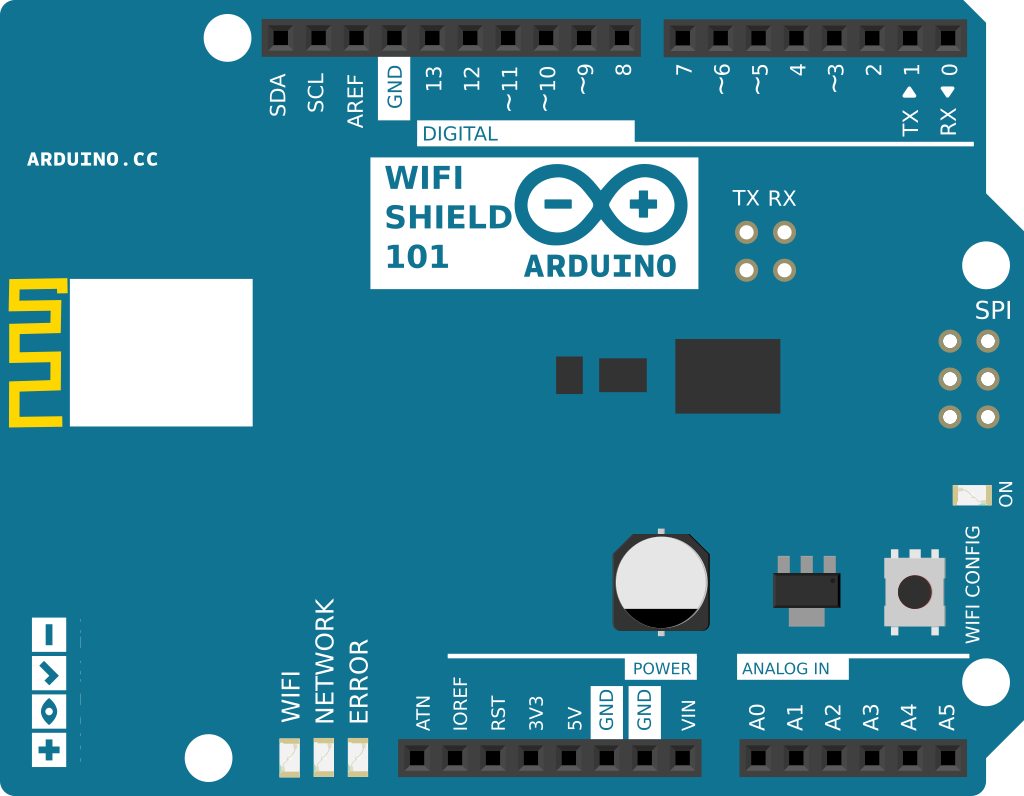码丁实验室,一站式儿童编程学习产品,寻地方代理合作共赢,微信联系:leon121393608。
Network Time Protocol (NTP) Client
- 在这个例子中,您将使用 WiFi Shield 101 和 Arduino 或者 Genuino Zero 开发板,来查询网络时间协议(NTP)服务器。这样,你的开发板可以从互联网上获得时间。
硬件要求
- Arduino WiFi Shield 101
- Arduino or Genuino Zero board
或者 - MKR1000
电路
- 数字引脚7被用来作为WiFi Shield 101 和 开发板的握手引脚使用,而不应该被占用。
- 这个例子里你应该进入一个连接到互联网的802.11b/g无线网络。你需要改变程序里的网络设置来符合您的特定网络SSID。

图由 Fritzing 绘制
在上图,Arduino 或 Genuino Zero 开发板应该在堆叠在 WiFi shield上面。
样例代码
/*
Udp NTP Client
Get the time from a Network Time Protocol (NTP) time server
Demonstrates use of UDP sendPacket and ReceivePacket
For more on NTP time servers and the messages needed to communicate with them,
see http://en.wikipedia.org/wiki/Network_Time_Protocol
created 4 Sep 2010
by Michael Margolis
modified 9 Apr 2012
by Tom Igoe
This code is in the public domain.
*/
#include <SPI.h>
#include <WiFi101.h>
#include <WiFiUdp.h>
int status = WL_IDLE_STATUS;
char ssid[] = "mynetwork"; // your network SSID (name)
char pass[] = "mypassword"; // your network password
int keyIndex = 0; // your network key Index number (needed only for WEP)
unsigned int localPort = 2390; // local port to listen for UDP packets
IPAddress timeServer(129, 6, 15, 28); // time.nist.gov NTP server
const int NTP_PACKET_SIZE = 48; // NTP time stamp is in the first 48 bytes of the message
byte packetBuffer[ NTP_PACKET_SIZE]; //buffer to hold incoming and outgoing packets
// A UDP instance to let us send and receive packets over UDP
WiFiUDP Udp;
void setup()
{
// Open serial communications and wait for port to open:
Serial.begin(9600);
while (!Serial) {
; // wait for serial port to connect. Needed for native USB port only
}
// check for the presence of the shield:
if (WiFi.status() == WL_NO_SHIELD) {
Serial.println("WiFi shield not present");
// don't continue:
while (true);
}
// attempt to connect to Wifi network:
while ( status != WL_CONNECTED) {
Serial.print("Attempting to connect to SSID: ");
Serial.println(ssid);
// Connect to WPA/WPA2 network. Change this line if using open or WEP network:
status = WiFi.begin(ssid, pass);
// wait 10 seconds for connection:
delay(10000);
}
Serial.println("Connected to wifi");
printWifiStatus();
Serial.println("nStarting connection to server...");
Udp.begin(localPort);
}
void loop()
{
sendNTPpacket(timeServer); // send an NTP packet to a time server
// wait to see if a reply is available
delay(1000);
if ( Udp.parsePacket() ) {
Serial.println("packet received");
// We've received a packet, read the data from it
Udp.read(packetBuffer, NTP_PACKET_SIZE); // read the packet into the buffer
//the timestamp starts at byte 40 of the received packet and is four bytes,
// or two words, long. First, esxtract the two words:
unsigned long highWord = word(packetBuffer[40], packetBuffer[41]);
unsigned long lowWord = word(packetBuffer[42], packetBuffer[43]);
// combine the four bytes (two words) into a long integer
// this is NTP time (seconds since Jan 1 1900):
unsigned long secsSince1900 = highWord << 16 | lowWord;
Serial.print("Seconds since Jan 1 1900 = " );
Serial.println(secsSince1900);
// now convert NTP time into everyday time:
Serial.print("Unix time = ");
// Unix time starts on Jan 1 1970. In seconds, that's 2208988800:
const unsigned long seventyYears = 2208988800UL;
// subtract seventy years:
unsigned long epoch = secsSince1900 - seventyYears;
// print Unix time:
Serial.println(epoch);
// print the hour, minute and second:
Serial.print("The UTC time is "); // UTC is the time at Greenwich Meridian (GMT)
Serial.print((epoch % 86400L) / 3600); // print the hour (86400 equals secs per day)
Serial.print(':');
if ( ((epoch % 3600) / 60) < 10 ) {
// In the first 10 minutes of each hour, we'll want a leading '0'
Serial.print('0');
}
Serial.print((epoch % 3600) / 60); // print the minute (3600 equals secs per minute)
Serial.print(':');
if ( (epoch % 60) < 10 ) {
// In the first 10 seconds of each minute, we'll want a leading '0'
Serial.print('0');
}
Serial.println(epoch % 60); // print the second
}
// wait ten seconds before asking for the time again
delay(10000);
}
// send an NTP request to the time server at the given address
unsigned long sendNTPpacket(IPAddress& address)
{
//Serial.println("1");
// set all bytes in the buffer to 0
memset(packetBuffer, 0, NTP_PACKET_SIZE);
// Initialize values needed to form NTP request
// (see URL above for details on the packets)
//Serial.println("2");
packetBuffer[0] = 0b11100011; // LI, Version, Mode
packetBuffer[1] = 0; // Stratum, or type of clock
packetBuffer[2] = 6; // Polling Interval
packetBuffer[3] = 0xEC; // Peer Clock Precision
// 8 bytes of zero for Root Delay & Root Dispersion
packetBuffer[12] = 49;
packetBuffer[13] = 0x4E;
packetBuffer[14] = 49;
packetBuffer[15] = 52;
//Serial.println("3");
// all NTP fields have been given values, now
// you can send a packet requesting a timestamp:
Udp.beginPacket(address, 123); //NTP requests are to port 123
//Serial.println("4");
Udp.write(packetBuffer, NTP_PACKET_SIZE);
//Serial.println("5");
Udp.endPacket();
//Serial.println("6");
}
void printWifiStatus() {
// print the SSID of the network you're attached to:
Serial.print("SSID: ");
Serial.println(WiFi.SSID());
// print your WiFi shield's IP address:
IPAddress ip = WiFi.localIP();
Serial.print("IP Address: ");
Serial.println(ip);
// print the received signal strength:
long rssi = WiFi.RSSI();
Serial.print("signal strength (RSSI):");
Serial.print(rssi);
Serial.println(" dBm");
}
[Get Code]
更多
- WiFi library – WiFi101 库的参考网页
- WiFi Shield – WiFi 扩展板 101 的产品细节
- MKR1000 – MKR1000 板的产品细节
- Connect No Encryption: 演示如何连接到一个开放的网络。
- Connect With WEP: 演示如何连接到用WEP加密的网络。
- Connect With WPA: 演示如何连接到一个用WPA2个人加密网络。
- Scan Networks:显示出所有在范围内的无线网络。
- Simple Web Server WiFi: 通过打开和关闭一个LED来访问这个简单的Web服务器
- UDP NTP Client: 通过UDP查询网络时间协议(NTP)服务器。
- WiFi Chat Server: 建立一个简单的聊天服务器。
- WiFi Web Client: 连接到一个远程服务器。
- WiFi Web Client Repeating: 反复做HTTP请求到服务器。
- WiFi Web Server: 通过模拟输入值来服务一个来自WIfi无线扩展块的网页。
- WiFi Send Receive UDP String: 发送和接收UDP字符串。

